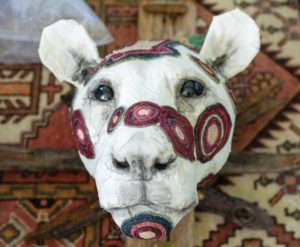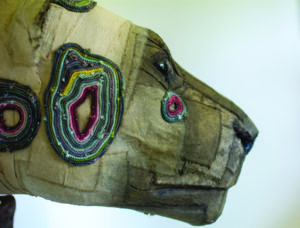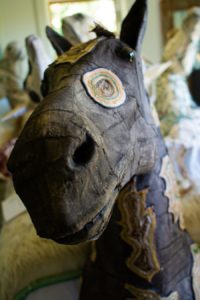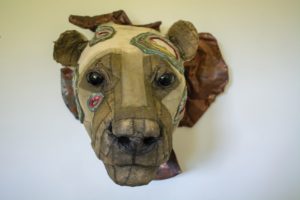The artist Gin Stone defies labeling, which is what makes her and her work so intriguing. One might say it is multidisciplinary, perhaps sculptural; but those terms only skim the surface of what’s behind her art. What one clearly sees is that her sculpture and arras, which will be on display for a week starting Aug. 5 at On Center Gallery in Provincetown, are the inevitable product of a self-described “huge nerd.”

“Growing up, I wanted to be Indiana Jones’s kid,” she says.
Her studio space is as much a cabinet of curiosity as it is a workspace for making art. A mostly self-taught artist, Stone is also self-taught in the ways of the world — scientific, religious, and philosophical — and she continues to follow her own innate curiosity and imagination wherever they lead her.

The titles of her animal sculptures are genus and species names paired with what inspired her, such as penicillin. But her arras are inspired by the brushwork of the painter Joan Mitchell and the quilts by Gee’s Bend, an isolated African-American hamlet in Alabama. Her greatest fear isn’t on the list of typical artist anxieties: Will I get a show? Will they like my work? Stone fears getting bored.
“When I get bored, I move on,” she says.
Stone started by studying painting at Hartford Art School. “I had a scholarship to go to an all-girls art school, but my mother wanted me to get a liberal arts degree,” she says. “It was like being in high school all over again. There were jocks, and the artists were the weirdos.” After two years, she dropped out.
But she really wasn’t a painter anyway, even though she was achieving a certain amount of what some people might consider success. “I had this show in Los Angeles, and I had to go around and talk about my work,” she says. “I realized I had nothing to say; I wasn’t invested in it.” She had what she calls “painter’s block.”
In the 1990s, still painting, Stone worked by day as a graphic designer in Manhattan until 9/11, which shook her to her core.
“I couldn’t be in New York anymore,” she says. “My landlord came home covered in dust. I would be in Port Authority and pass all the missing person signs, and I couldn’t take it.”

By February 2002 she had moved to Eastham, not knowing a soul here. “It was either Maine or Cape Cod, and Maine was too cold,” she says.
On the Cape, Stone finally got over her years of painter’s block. She was walking along the beach, picking up bits and pieces that had washed ashore, including ghost gear (commercial fishing line). Still thinking like a painter, she took the fishing line home and played with it, applying it to a canvas. But she was still stuck. It was when a friend suggested she wrap the line around things that a light went on. She had found an outlet for everything: all her interests and passions and the connections she saw in them. A way to not get bored.

“Suddenly, I realized I had a way to make things like a chimera and combine myths and the patterns I love from geodes and agates and molds and stains,” Stone says. “Science, mythology, anthropology — it’s all hugely important to me.”
She points to a tattoo on her arm, an ouroboros by the 3rd-century Greek alchemist Cleopatra, that encompasses her life’s philosophy. The tattoo depicts a snake swallowing its tail, signifying the unity of all things, and how they never disappear, they only change forms. Stone incorporates everything from old dog tags from her parents’ house to drawer pulls and old pieces of copper flashing from a roof.
“I’ll use whatever I can find,” she says.
One of the many found materials Stone continues to incorporate into her work is a large supply of netting she acquired from the Center for Coastal Studies that the F/V Donna Marie out of Provincetown snagged in 100 fathoms of water in the Atlantic. It’s important to her to know as much as she can about the material, including in this case, the exact coordinates of where the netting was found: 42°10’N 69°52’W.
“I find it fascinating to know exactly where something came from,” she says. “It’s like digging something out of the earth and knowing it was made 3,000 years ago. It’s material-based information, and I find that information fascinating. Using materials and knowing where it came from is archeological and art and everything wonderful.”

The intense focus on detail that Stone pours into her work may on the surface appear to be esoteric, even mundane. But always trust the artist’s intuition: in the end, her fascination seems to give her work its own special life, as if the material is being reborn into fantastical reincarnations — new things unto themselves.
Found Materials
The event: An exhibit of works by Gin Stone: Animal, vegetable, mineral
The time: Aug. 5 to 11
The place: On Center Gallery, 352 Commercial St., Provincetown
The cost: Free
